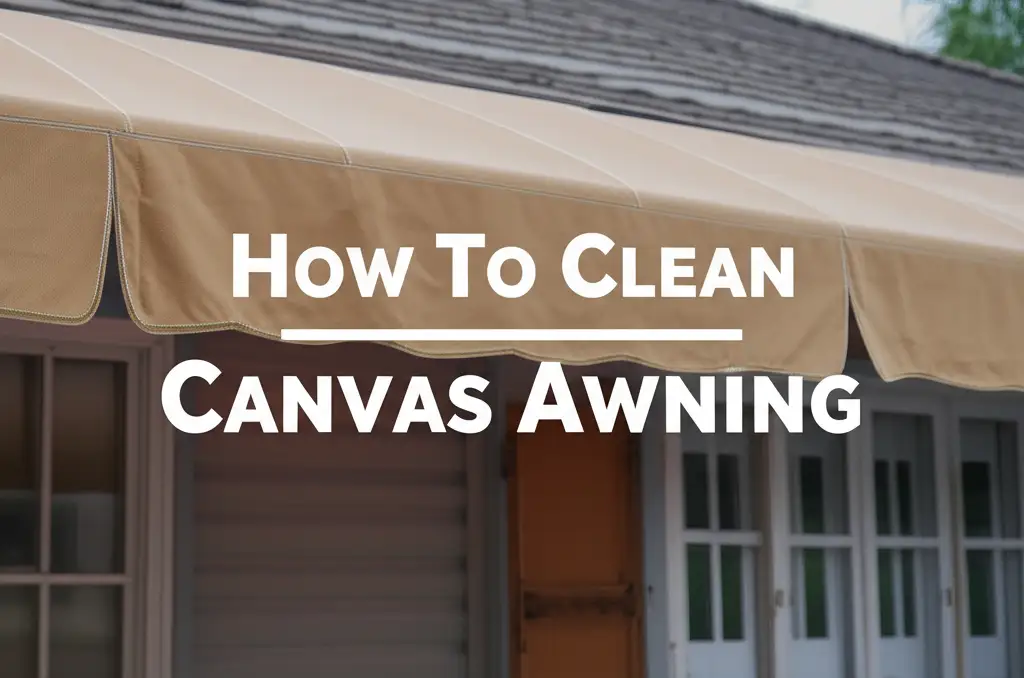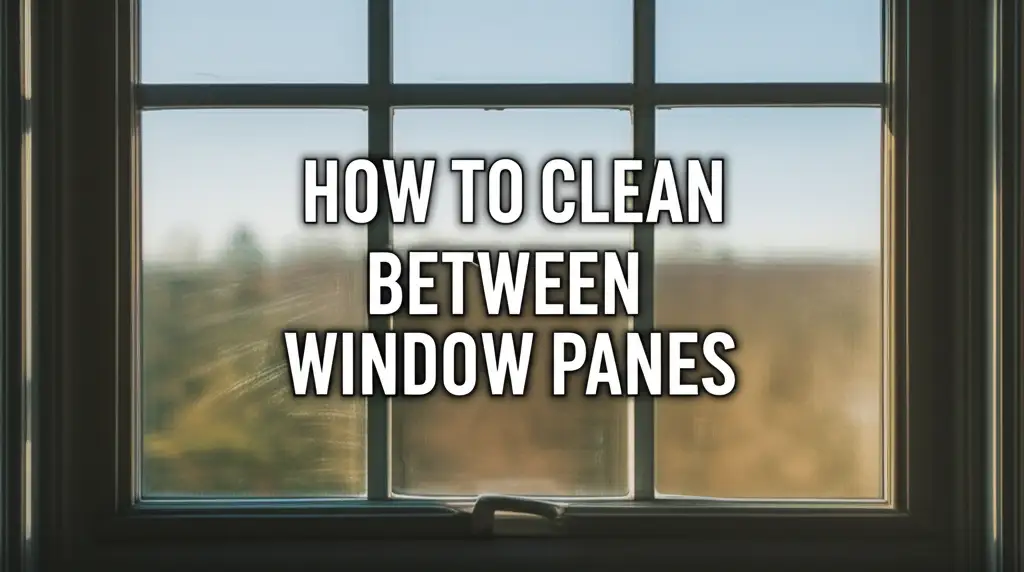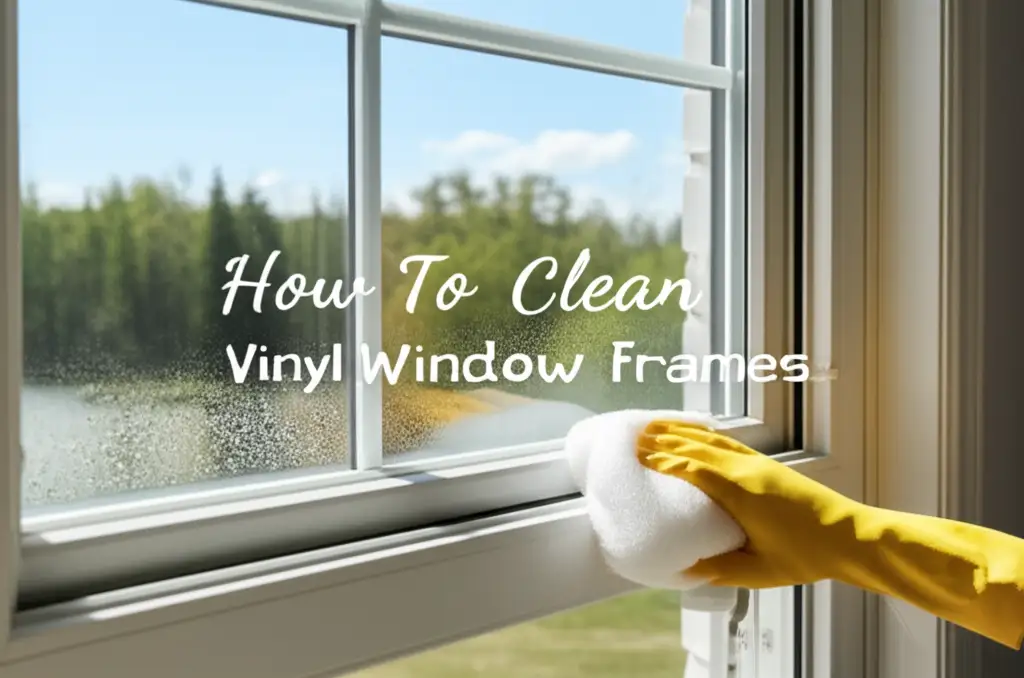· Home Maintenance · 15 min read
How To Clean Canvas Awning

How To Clean Canvas Awning: A Complete Guide to Revitalization
Does your outdoor space feel less inviting because of a dirty canvas awning? A clean awning instantly brightens your patio or deck. Learning how to clean canvas awning fabric is simpler than you might think. This guide gives you easy, actionable steps. You will learn the right tools and methods for different types of dirt. We will cover everything from basic washing to tough stain removal. Get ready to make your canvas awning look new again.
Takeaway:
- Gather the right tools and cleaning solutions before you start.
- Always remove loose debris first with a soft brush or vacuum.
- Use gentle cleaning methods for regular maintenance to protect the fabric.
- Address mold and mildew quickly with specific, effective treatments.
- Rinse the awning thoroughly to prevent soap residue buildup.
- Allow the awning to dry completely before rolling it up.
- Apply a fabric protector to extend its cleanliness and lifespan.
To clean a canvas awning, first remove loose dirt with a soft brush. Then, prepare a mild soap solution and apply it with a soft-bristle brush. Scrub gently to lift grime. Rinse the awning thoroughly with clean water. Allow it to air dry completely before retracting it.
Why Regular Awning Cleaning Matters
Your canvas awning faces the elements every day. Sun, rain, dust, and pollen constantly settle on its surface. This exposure causes dirt buildup and can lead to mildew or mold. Regular cleaning prevents these issues from becoming severe. It also extends the life of your awning fabric. A clean awning looks better and lasts longer.
Ignoring a dirty awning can cause permanent damage. Mold and mildew can eat away at the fabric over time. Dirt and grime can become deeply embedded. This makes cleaning much harder later. Taking a little time for routine maintenance saves you money and effort. It keeps your outdoor area looking welcoming.
Canvas awnings are durable but need care. Think of it like washing your car. You wash it to keep it shiny and protect the paint. Awnings need similar attention. This care ensures your outdoor investment serves you well for many years. It maintains the fabric’s color and integrity.
Preparing for Your Awning Cleaning Project
Before you begin cleaning your canvas awning, gather all necessary supplies. Having everything ready makes the process smooth. You will need certain tools and cleaning agents. Safety is also very important during this work. Make sure your workspace is secure.
Start by checking the weather forecast. Choose a mild, overcast day. Direct sunlight can dry cleaning solutions too fast. This can leave streaks or marks. You want the fabric to stay wet for a while during cleaning. A calm day also makes working with the awning easier.
Essential Cleaning Tools and Materials
- Soft-bristle brush: This is crucial for scrubbing without damaging the canvas. Avoid stiff brushes.
- Garden hose with spray nozzle: For rinsing the awning thoroughly. A powerful jet can damage fabric.
- Bucket(s): To mix your cleaning solution and hold water.
- Mild soap: Dish soap or a specialized outdoor fabric cleaner works well. Avoid harsh detergents.
- Optional: Ladder, safety glasses, gloves.
- Specific products: If dealing with mold or tough stains, you might need specific removers. Always check product labels.
Safety First: Important Precautions
Working on an awning often means working at height. Use a sturdy ladder if your awning is high. Have someone spot you if possible. Wear appropriate non-slip shoes. Protect your eyes with safety glasses, especially when spraying solutions. Gloves protect your hands from cleaning agents.
If your awning is retractable, ensure it is fully extended. Lock it in place if your model allows. This gives you a stable surface to work on. Make sure no power cords are in the way. Always read the instructions on any cleaning products you use. Follow their safety guidelines carefully.
The Basic Steps to Clean Canvas Awning Fabric
Regular cleaning keeps your canvas awning looking great. This basic cleaning method removes surface dirt and grime. It prevents deeper stains from forming. You should aim to do this type of cleaning every few months. It is simple and effective.
Begin by removing any loose debris. Use a soft brush or a vacuum cleaner. Brush off leaves, twigs, and loose dirt from the top and bottom of the awning. This step is important. It prevents scratching the fabric during wet cleaning. You do not want to rub dirt into the canvas.
Next, prepare your cleaning solution. Mix about 1/4 cup of mild dish soap into a gallon of lukewarm water. You can also use a specific outdoor fabric cleaner following its directions. Test the solution on a small, hidden area of the awning first. This ensures it does not cause discoloration.
Gentle Washing Technique
- Wet the awning: Lightly spray the entire awning surface with water from your garden hose. Do not use high pressure. Just get the canvas damp.
- Apply the solution: Dip your soft-bristle brush into the cleaning solution. Apply it evenly to the entire canvas surface. Work in small sections if your awning is large.
- Gentle scrubbing: Gently scrub the fabric with the brush. Use circular motions. Focus on areas with visible dirt or light stains. Do not scrub too hard. Hard scrubbing can damage the fabric fibers or remove protective coatings.
- Let it soak (briefly): Allow the solution to sit on the fabric for about 5-10 minutes. This gives the soap time to break down the dirt. Do not let it dry.
- Rinse thoroughly: Rinse the awning completely with clean water from your garden hose. Start from the top and work your way down. Make sure no soap residue remains. Residue can attract more dirt later or cause mildew. Rinse until the water runs clear.
This basic method is effective for most routine dirt. If your awning has specific stains or mold, you will need a more targeted approach. However, this step is a good starting point for any canvas awning. For specific brand guidance, you can also learn how to clean Sunsetter awning. The principles often apply across different canvas awning types.
Tackling Stubborn Stains, Mold, and Mildew
Sometimes, basic cleaning is not enough. Canvas awnings can develop tough stains from tree sap, bird droppings, or food spills. Mold and mildew are also common problems, especially in damp climates. These require specific treatments. Act quickly when you notice them to prevent permanent damage.
Before treating any stain, always test your cleaning solution on an inconspicuous spot. This ensures it will not bleach or harm the fabric color. Different stains need different approaches. Do not mix cleaning products unless the labels specifically say it is safe.
Removing Mold and Mildew from Canvas
Mold and mildew appear as black, green, or white spots. They thrive in damp, shady conditions. They can quickly spread and cause unpleasant odors. Addressing them promptly is key.
- Brush off loose mold: First, dry brush any loose mold spores from the surface. Do this gently to avoid spreading the spores. Wear gloves and a mask if mold is extensive.
- Prepare a specialized solution: Mix 1/4 cup of bleach with 1 gallon of water for stubborn mold. For a non-bleach option, mix 1 cup of vinegar with 1 gallon of water. Vinegar is a good natural alternative. It is effective against many types of mold. You can learn more about how to clean mold with vinegar.
- Apply and scrub: Apply the solution to the moldy areas with a soft brush. Let it soak for 10-15 minutes. Scrub the affected areas gently. Make sure the solution penetrates the mold growth.
- Rinse thoroughly: Rinse the entire awning with clean water. Ensure all traces of the cleaning solution are gone. Bleach can weaken fabric if not rinsed fully. Vinegar also needs rinsing to prevent odor.
- Repeat if necessary: For very stubborn mold, you may need to repeat the process. Multiple light treatments are better than one strong treatment. If you have experience cleaning mold from other surfaces, like how to clean mold in shower, these methods can be similar.
Dealing with Other Common Stains
- Bird Droppings/Tree Sap: Scrape off as much as possible once dry. Then, apply a solution of mild soap and water. Gently scrub. For stubborn sap, rubbing alcohol on a cloth can help, but test it first. Rinse well.
- Food/Grease Stains: Blot fresh stains immediately with a clean cloth. For dried stains, use a mild fabric spot cleaner. Apply it directly to the stain. Let it sit for a few minutes. Gently blot or scrub. Rinse the area thoroughly.
- Rust Stains: These can be tricky. Try a rust remover specifically designed for outdoor fabrics. Follow product instructions carefully. Often, these contain oxalic acid, which needs careful handling and thorough rinsing.
Always remember to rinse the awning completely after any spot treatment. Any residue left behind can attract more dirt or cause fabric degradation over time. Patience is key when dealing with tough stains.
Rinsing and Drying Your Canvas Awning Properly
Proper rinsing and drying are just as important as the cleaning itself. If you do not rinse thoroughly, soap residue will remain. This residue attracts dirt quickly. It can also promote mildew growth. Incomplete drying leads to mildew and a musty smell. Take your time with these final steps.
After scrubbing your canvas awning, it is time for a thorough rinse. Use your garden hose with a standard spray nozzle. Avoid high-pressure washers. High pressure can damage the canvas fibers or remove water-resistant coatings. Start rinsing from the top of the awning. Let the water run down.
Continue rinsing until no more suds appear. The water should run clear. Pay extra attention to seams and folded areas. These spots can trap soap. Run your hand over the fabric. It should feel clean, not slippery from soap. A good rinse is crucial for long-term cleanliness.
The Importance of Complete Drying
Once rinsed, your canvas awning needs to dry completely. This step is vital to prevent mold and mildew. Never roll up or store a damp awning. Even slightly damp fabric can lead to significant problems.
- Air Dry Fully: Extend the awning fully. Let it air dry in the open. A breezy day is ideal for drying. This allows air to circulate around the fabric.
- Check All Sides: Make sure both the top and bottom surfaces are dry. Check hidden folds or pockets where water might collect.
- Patience is Key: Drying can take several hours, especially on humid days. If it starts to rain, retract the awning temporarily. Re-extend it when the weather clears to finish drying. Do not rush this step.
If you roll up a damp awning, you create a perfect environment for mildew. This can cause unsightly stains and a bad smell. It also shortens the life of your canvas. Once your awning is completely dry, you can retract it safely.
Protecting Your Canvas Awning for Longevity
Cleaning your canvas awning is a great start. But keeping it clean and protected is even better. Applying a fabric protector after cleaning can extend its life significantly. These protectors create a barrier. This barrier repels water and resists stains. It makes future cleanings much easier.
Fabric protectors are designed to restore water repellency. They also help block harmful UV rays. This prevents fading and degradation of the canvas. You should reapply these protectors periodically. The frequency depends on your local weather conditions and awning usage. Follow the product manufacturer’s recommendations.
Applying a Fabric Protector
- Ensure it’s clean and dry: The awning must be perfectly clean and completely dry before application. Any dirt or moisture will get sealed in.
- Choose the right product: Select a fabric protector specifically for outdoor canvas or marine fabrics. Brands like 303 Fabric Guard or Star Brite are popular choices.
- Apply evenly: Spray the protector evenly over the entire surface of the awning. Work in sections. Overlap your sprays slightly. Avoid over-saturating the fabric.
- Allow to cure: Let the protector dry and cure according to the product instructions. This often takes several hours or even a full day. Do not expose the awning to rain during this time.
Regular Maintenance Tips to Extend Awning Life
Beyond deep cleaning, consistent small actions prolong your awning’s beauty and function. A little routine maintenance goes a long way. These habits prevent serious problems from developing. They keep your canvas awning in top condition year-round.
- Brush off debris frequently: Every few weeks, take a soft broom or brush. Gently sweep off leaves, pollen, and loose dirt. This prevents buildup.
- Rinse with water: If your awning gets dusty, a quick rinse with a garden hose is helpful. Do this on a sunny day so it dries quickly.
- Address spills immediately: If anything spills on the awning, clean it right away. Fresh spills are easier to remove than dried ones.
- Check for damage: Periodically inspect your awning for small tears, loose stitching, or weak spots. Repairing minor issues early prevents them from becoming major problems.
- Winter storage (if applicable): If you live in an area with harsh winters, consider retracting your awning. Or remove it if it’s a portable type. Store it in a dry, protected place. Make sure it is completely dry before storing.
- Avoid harsh chemicals: Never use strong bleaches, abrasive cleaners, or stiff brushes. These can damage the fabric and its protective coatings. Stick to mild soap and water for routine cleaning.
- Trim nearby trees: If tree branches overhang your awning, trim them back. This reduces falling leaves, sap, and bird droppings.
- Ensure proper drainage: Make sure water runs off your awning freely. Pockets of standing water can lead to mildew and fabric stretching.
By following these simple maintenance tips, you ensure your canvas awning remains a beautiful and functional part of your outdoor living space for many years. Regular care protects your investment.
Common Mistakes to Avoid When Cleaning Canvas Awnings
Cleaning your canvas awning properly requires attention to detail. Many common mistakes can actually harm your awning or make cleaning less effective. Knowing what to avoid is as important as knowing what to do. Protect your investment by steering clear of these pitfalls.
- Using High-Pressure Washers: This is a very common mistake. High-pressure water can damage the fabric weave. It can also strip away protective coatings. Always use a gentle stream from a garden hose.
- Using Harsh Chemicals: Avoid bleach (unless for severe mold in very diluted form and with caution), ammonia, or strong detergents. These chemicals can discolor the canvas. They can also degrade the fabric fibers over time. Stick to mild soaps or specialized fabric cleaners.
- Scrubbing Too Hard: Aggressive scrubbing with stiff brushes can abrade the canvas. This damages the fabric and can remove its protective layer. Use a soft-bristle brush and gentle, circular motions.
- Not Rinsing Thoroughly: Leaving soap residue on the awning attracts dirt faster. It also promotes mildew growth. Rinse until all suds and residue are gone.
- Retracting/Storing While Damp: This is a recipe for mold and mildew. Always ensure your canvas awning is completely dry before rolling it up. Mold can cause permanent stains and an unpleasant smell.
- Ignoring Small Stains: Little stains become big problems if left untreated. Address spills and marks as soon as you notice them. This makes cleaning much easier.
- Cleaning in Direct Sunlight: The sun can dry cleaning solutions too quickly. This leaves streaks and prevents the cleaner from working effectively. Clean on a mild, overcast day.
- Not Testing Cleaners: Always test any new cleaning solution on a small, hidden area first. This prevents accidental damage or discoloration to your entire awning.
By avoiding these common errors, you can clean your canvas awning safely and effectively. You will preserve its appearance and extend its useful life. Proper technique ensures your awning looks great for seasons to come.
FAQs About Cleaning Canvas Awnings
How often should I clean my canvas awning?
You should clean your canvas awning at least once a year. For awnings in high-pollen areas or those exposed to a lot of dirt, clean it every few months. Regular light cleaning, like brushing off debris, should happen more frequently. This prevents stubborn buildup.
Can I use a regular household cleaner on my canvas awning?
It is best to use mild dish soap or a cleaner specifically for outdoor fabrics. Avoid harsh household cleaners like bleach or ammonia-based products. These can damage the fabric, remove waterproof coatings, or fade the color. Always check the label.
How do I remove black mold spots from my canvas awning?
For mold, mix 1 cup of white vinegar with 1 gallon of water. For tougher mold, use 1/4 cup of bleach per gallon of water. Apply the solution with a soft brush, let it sit for 10-15 minutes, then scrub gently. Rinse thoroughly with clean water. Ensure the awning dries completely.
Do I need to re-waterproof my canvas awning after cleaning?
After a deep cleaning, especially if you used stronger solutions, reapplying a fabric protector is a good idea. Cleaning can reduce the fabric’s water repellency. A fabric guard restores this protection, helping to repel water and resist future stains.
What should I do if my awning has a strong mildew smell?
A strong mildew smell means mold or mildew is present. You need to clean the awning thoroughly using a mold-specific solution. Make sure to scrub all affected areas. The most crucial step is to let the awning air dry completely. Do not roll it up until it is bone dry.
Can I machine wash my canvas awning?
No, you should never machine wash a canvas awning. Awnings are too large and heavy for washing machines. Machine washing can damage both the awning and the machine. Always clean your canvas awning manually while it is installed.
Conclusion
Cleaning your canvas awning is a straightforward process that offers great rewards. You have learned how to clean canvas awning fabric effectively, from basic dirt removal to tackling stubborn mold and stains. We covered the right tools, proper techniques, and important safety tips. Remember that regular cleaning and maintenance are key to extending your awning’s life. By following these steps, you not only make your awning look new but also protect your investment. Keep your outdoor spaces vibrant and inviting. Start your awning cleaning project today!
- canvas awning
- awning cleaning
- outdoor fabric care
- mold removal
- home maintenance
- Sunbrella cleaning
- DIY cleaning




